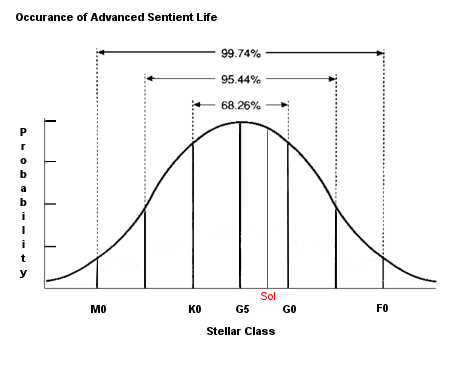It looks like you're using an Ad Blocker.
Please white-list or disable AboveTopSecret.com in your ad-blocking tool.
Thank you.
Some features of ATS will be disabled while you continue to use an ad-blocker.
share:
originally posted by: tanka418 If we attempt to apply a statistical bell curve to the stars, in our search for intelligent life we actually find that these "natural", and technological limitation, your "bias" are limiting our selection of stars to the curve. And, yes, this method will miss some...it is however a first approximation, so that data loss is acceptable.
And, Hipparcos still contains a large number of class "M" stars, which are included in all my queries.
It would seem somebody stole that gaussian curve from a French blog and relabeled it in MS paint.....
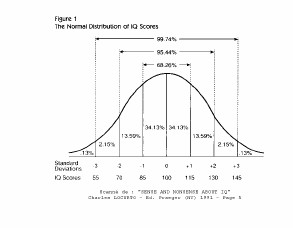
Source
originally posted by: Drunkenparrot
It would seem somebody stole that gaussian curve from a French blog and relabeled it in MS paint.....
Jump to conclusions much?
Actually, you don't have enough information to come to any sort of a conclusion on that...so, allow me to tell ya that you have missed that on all accounts...
Although, yes, "relabeled"; kind of had to so that it could convey the data I wished to convey...
edit on 15-4-2016 by tanka418 because: (no reason given)
a reply to: tanka418
Not all of them, only the most fundamental. Since you cannot even grasp the need for a control group of randomly selected points I have no hope you will grasp the more subtle points of interpretation.
See what I mean? It has been proven without doubt that your so called "template" can be applied to random dots, random stars, and even cities in England. This means that it can be applied to a biased set of data and create the illusion of meaning, when in fact it is coincidence and bias.
I keep explaining that there is a control group. Remember my analogy of the left handed bald men? Your Hipparcos data are the left handed bald men. In order to see if your correlation between being left handed, bald, and criminal is valid, you need to compare the statistics to another population. If that other population has the same crime rate, the correlation is not valid, but the result of "cherry picking." The random collection of dots, stars, and English cities are the control groups here. Since your "template" fit them all, your identification of the stars in the Hipparcos data is just coincidence; the meaning you project on to it is the result of confirmation bias.
So are you admitting that you don't think and reason like the aliens? That is what the first part of your statements mean. You then contradict yourself and claim that it does think like you. I am not the one who is logic impaired here.
How can you accept bizarre lapses of logic and consistency in the Hills' story as being the result of drugs, then turn around and assume that Betty's map was anything but a figment of her imagination?
I have! You just pretend you can't see it.
Have you now...explained all my methodological error eh?
Not all of them, only the most fundamental. Since you cannot even grasp the need for a control group of randomly selected points I have no hope you will grasp the more subtle points of interpretation.
Well, perhaps in your mind. So you came off with some "methodological"...stuff. Like that wee bit about the "control group"...that one was really rich...
See what I mean? It has been proven without doubt that your so called "template" can be applied to random dots, random stars, and even cities in England. This means that it can be applied to a biased set of data and create the illusion of meaning, when in fact it is coincidence and bias.
Do you understand that there is no control group for this sort of thing? Seriously man, there is no way to build one. Well, perhaps IF you could get those "random dot" Hipparcos star matches, that might be a sort of start.
I keep explaining that there is a control group. Remember my analogy of the left handed bald men? Your Hipparcos data are the left handed bald men. In order to see if your correlation between being left handed, bald, and criminal is valid, you need to compare the statistics to another population. If that other population has the same crime rate, the correlation is not valid, but the result of "cherry picking." The random collection of dots, stars, and English cities are the control groups here. Since your "template" fit them all, your identification of the stars in the Hipparcos data is just coincidence; the meaning you project on to it is the result of confirmation bias.
This implies that you understand how the aliens think and reason.
Again, only in your imagination. Although, it seems reasonable, that IF ET can travel here from his home world, that ET is a logical, sensible creature, an thus does in fact "think" much like me... But, I do understand that you may have issues fathoming the logic and reason here.
So are you admitting that you don't think and reason like the aliens? That is what the first part of your statements mean. You then contradict yourself and claim that it does think like you. I am not the one who is logic impaired here.
On that spacecraft "windshield"; the misinterpretation that comes with the Orexin deprived brain...ya know, not being awake, while not sleeping isn't a typical state for any of us...that and they don't want any bugs stuck in their teeth...
How can you accept bizarre lapses of logic and consistency in the Hills' story as being the result of drugs, then turn around and assume that Betty's map was anything but a figment of her imagination?
Oh, and I would really like you to point out arbitrary...I can find it anywhere, maybe I see something you refuse to...
I have! You just pretend you can't see it.
edit on 15-4-2016 by
DJW001 because: (no reason given)
originally posted by: DJW001
See what I mean? It has been proven without doubt that your so called "template" can be applied to random dots, random stars, and even cities in England. This means that it can be applied to a biased set of data and create the illusion of meaning, when in fact it is coincidence and bias.
You are really full of surprises aren't you. Wow, who would have thought that the template could be successfully applied to a field with enough random points to match anything!
You have yet to prove anything at all of relevance!!!
Seriously, you have twisted, contorted, the issues here until, in your mind, you have somehow won something. You haven't, and all you have done is demonstrate that you have no understanding of the problem.
so how about we just reiterate it for the casual reader, assuming you haven't chased than all away with your fraudulent BS.
We have a set of 25 presumable random point. We wish to see if there is a "match" to the stars in the sky, and determine the probability of such a match. So to that end, we use the Mathematical probability to compute those probabilities. To do so requires, mathematically, that we compute the first 25 terms of the number of possible selections we have...
In this case it works out to 1.7e86...a very large number...Your problem here is that you don't have the math background to know how this is done, so, you try to rely on "layman's science" which for all it is, is typically in error...like you.
So there is you chance of coincidence!!!
1:170,000,000,000,000,000,000,000,000,000,000,000,000,000,000,
000,000,000,000,000,000,000,000,000,000,000,000,000,000
Oh look...the chance of coincidence is almost nonexistent!!!
Now then DJW001, I don't expect you to understand the mathematics involved here, but, you really could find out before you make something up and insist that it is reality...to insist upon your fantasy is fraudulent, especially as you refuse to offer any evidence, or data in support...and so far; it seems I am the only one with supporting data...
I keep explaining that there is a control group. Remember my analogy of the left handed bald men? Your Hipparcos data are the left handed bald men. In order to see if your correlation between being left handed, bald, and criminal is valid, you need to compare the statistics to another population. If that other population has the same crime rate, the correlation is not valid, but the result of "cherry picking." The random collection of dots, stars, and English cities are the control groups here. Since your "template" fit them all, your identification of the stars in the Hipparcos data is just coincidence; the meaning you project on to it is the result of confirmation bias.
Please give my condolences to the irrelevant, inappropriate, and misapplied "left handed bald guys"; that was a really poor analogy!
I like that; "another population"...son we only got one population of galactic stars, and no matter how hard you try, you won't find another collection of stars, so we kind of gots to use the one we have! And, I can assure you they won't be cooperative.
Now you are insisting that something needed to validate a clinical trial is also needed to validate the stars...something directly measurable...
(do you know "why" a control group is used in clinical trials, and isn't needed in this exercise?)
-- chemistry.about.com...
A control group in a scientific experiment is a group separated from the rest of the experiment where the independent variable being tested cannot influence the results. This isolates the independent variable's effects on the experiment and can help rule out alternate explanations of the experimental results.
Something you refuse to accept is that this is NOT a scientific experiment...it is the mathematical evaluation of a set of probabilities...
You are lost and have no idea where to go!
How can you accept bizarre lapses of logic and consistency in the Hills' story as being the result of drugs, then turn around and assume that Betty's map was anything but a figment of her imagination?
Jesus! Son, I would have thought you might have figured that part out by now. The logic, and lapses of Betty Hill are kind of over-shadowed by the sheer improbability of the "map" (template) being random! The reality is, as I have said; the story can not affect the probability of the stars matching.
So, all you have done here is attempt to twist and contort reality to suit your needs, and have done so unsuccessfully. You want Betty's map to be coincidence, or rather NEED, but, someone with a little math came along and upset your "applecart"...poor lil ole DJW001...so now you are in a mode where yo have to make up, invent, or lie your way to safety...
Fortunately reality won't let you...Reality says you are wrong, I have presented more than enough data to support realities assertion here, so; you are wrong! And there is no make believe that will save you...So, now that you've had your say, and said nothing...please crawl back into you little world of make believe, and leave my theory alone...we don't need people with no knowledge confusing those who wish to learn and expand their horizons.
edit on 15-4-2016 by tanka418 because: (no reason given)
With the talk of "M" class stars being a "possibility" for a match in the template...I thought it might be interesting to "see" how many class "M"
stars might be "contenders" for a template match.
Unfortunately I started kind of late last night with this, so I only did one star...however, there are no class "M" stars within 12 arc minutes of Gliese 86...I'll be processing the others and building a report...
I'll make the results available in the "web app" I'm building based on the template as a GUI.
Unfortunately I started kind of late last night with this, so I only did one star...however, there are no class "M" stars within 12 arc minutes of Gliese 86...I'll be processing the others and building a report...
I'll make the results available in the "web app" I'm building based on the template as a GUI.
a reply to: tanka418
I have tried my best to explain to you that your methodology is meaningless. If you can match the template to a field of random dots, you can match the template to a field of stars. The stars are a set that is biased due to a number of factors. Your math is irrelevant. It has been demonstrated that the odds of matching the template to almost any given set of points is 100%. Your inability to grasp this simple fact has completely destroyed your credibility. Please do not waste any more of your time, or humiliate yourself further. I suggest you read some elementary material about the scientific method. You also need to review concepts like "data," "information," "analysis," and the various logical and statistical fallacies.
I have tried my best to explain to you that your methodology is meaningless. If you can match the template to a field of random dots, you can match the template to a field of stars. The stars are a set that is biased due to a number of factors. Your math is irrelevant. It has been demonstrated that the odds of matching the template to almost any given set of points is 100%. Your inability to grasp this simple fact has completely destroyed your credibility. Please do not waste any more of your time, or humiliate yourself further. I suggest you read some elementary material about the scientific method. You also need to review concepts like "data," "information," "analysis," and the various logical and statistical fallacies.
(post by tanka418 removed for a manners violation)
a reply to: tanka418
Example 1:
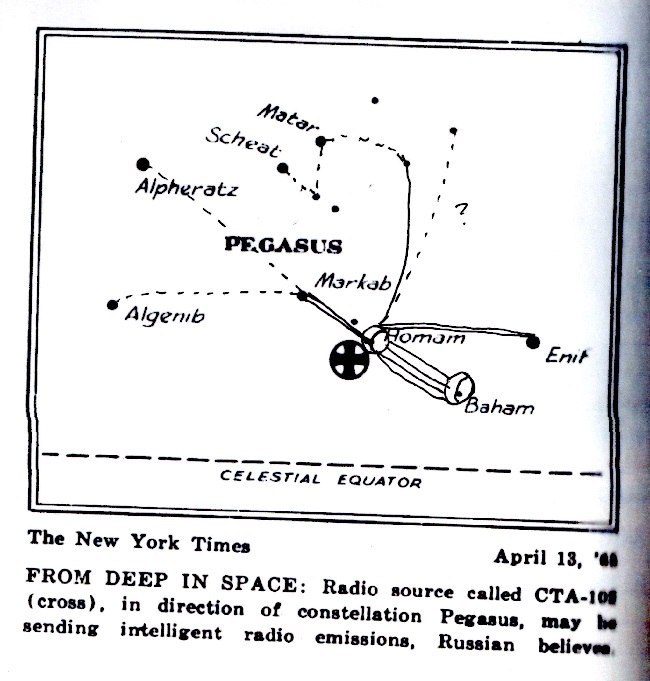
Example 2:
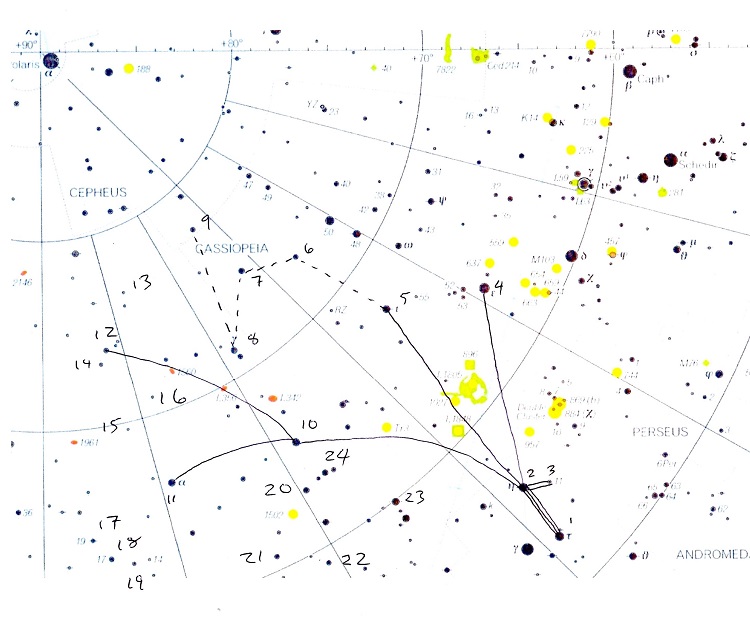
Example 3:

[Courtesy TerryDon79]
Example 4:
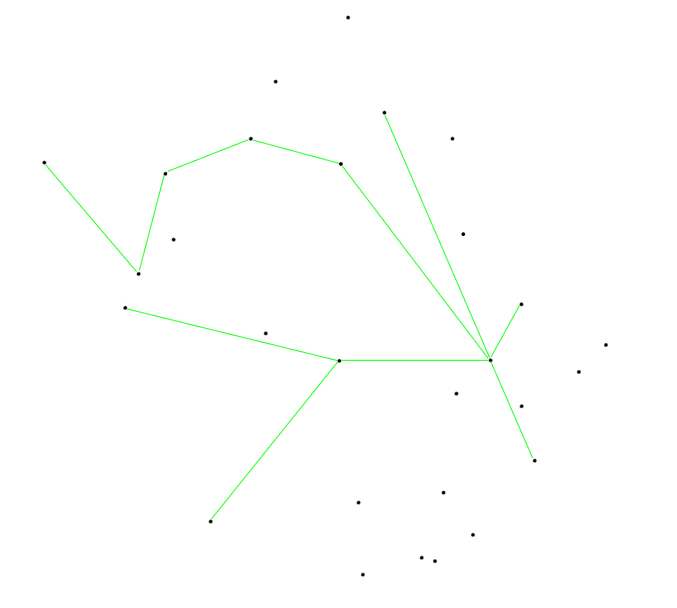
[Courtesy Ectoplasm8]
[Ill-mannered rant deleted--DJW001]
I'm sure this is not the first time someone has told you "garbage in, garbage out." The Hill map is not data, it is a drawing of something seen in a dream state. It is garbage. You have mapped the pattern onto a data set that is biased due to observational limitations. It has been demonstrated that there is a 100% certainty that this "template"can be forced onto any data set, therefore any information the process yields is due entirely to this observational bias. Once again, please review the concepts involved.
So do it!!! You keep saying this is easy, you even say it is a virtual 100%...so...talk is cheap! Actually show us!!
Example 1:

Example 2:

It has been demonstrated that the odds of matching the template to almost any given set of points is 100%.
No, you haven't demonstrated any such thing...you have avoided such exercises preferring to use rhetoric in hopes of confusing the reader enough that he gives up trying to understand...that is criminal!
Example 3:

[Courtesy TerryDon79]
Example 4:

[Courtesy Ectoplasm8]
[Ill-mannered rant deleted--DJW001]
ETA: I think it is kind of cute though, how you can't assail the actual data, and have to make stuff up about the methods...lol
I'm sure this is not the first time someone has told you "garbage in, garbage out." The Hill map is not data, it is a drawing of something seen in a dream state. It is garbage. You have mapped the pattern onto a data set that is biased due to observational limitations. It has been demonstrated that there is a 100% certainty that this "template"can be forced onto any data set, therefore any information the process yields is due entirely to this observational bias. Once again, please review the concepts involved.
originally posted by: tanka418
a reply to: DJW001
Before you go...I would like to thank you for helping me to "flesh out" my theory, I'm working on new material inspired by the less objectionable bits of your BS.
You're welcome. I hope you take the criticism in a positive way and learn from your mistakes.
originally posted by: DJW001
Well jeez...I was going to quote some stuff, but there's nothing worthy!
Ya know every one of those has been addressed, and shown to be just BS you are trying to use to pull the wool over everybody's eyes...
this image though has got to be a fave...

Just a bunch of unidentified lines and points(?)...no way to tell what it is really...and when you were asked, you declined to tell us what the star's IDs were...
Then of course some of your "wool" isn't an attempt to match to stars, so wholly irrelevant...
Sorry man, but you fail to make the "cut" yet again...
So again...put up or shut up.
Well jeez...I was going to quote some stuff, but there's nothing worthy!
Ya know every one of those has been addressed, and shown to be just BS you are trying to use to pull the wool over everybody's eyes...
this image though has got to be a fave...

Just a bunch of unidentified lines and points(?)...no way to tell what it is really...and when you were asked, you declined to tell us what the star's IDs were...
Then of course some of your "wool" isn't an attempt to match to stars, so wholly irrelevant...
Sorry man, but you fail to make the "cut" yet again...
So again...put up or shut up.
edit on 15-4-2016 by tanka418 because: (no reason given)
originally posted by: DJW001
originally posted by: tanka418
a reply to: DJW001
Before you go...I would like to thank you for helping me to "flesh out" my theory, I'm working on new material inspired by the less objectionable bits of your BS.
You're welcome. I hope you take the criticism in a positive way and learn from your mistakes.
I always take real criticism in a positive way...BS not so much!
originally posted by: tanka418
originally posted by: DJW001
a reply to: tanka418
Just a bunch of unidentified lines and points(?)...no way to tell what it is really...
Exactly like Betty Hill's original drawing.
Yet the points on Betty's map were successfully identified as to the specific star it is...
And the specific UK towns.
Just thought i'd offer this:
It shows the way the real world probabilities are computed for exercises like this one...
-- www.pas.rochester.edu...
Permutations and Combinations
Many problems in probability can be phrased in the language of "how many ways can we pick r objects out of a group of N objects." We now calculate the answer to this question.
If the order of the r objects is important, than the "number of ways to pick r objects out of a group of N objects" is called: the number of permutations of N objects taken r at a time, and denoted by the symbol NPr. What is the numerical value of NPr? For the 1st choice we can choose any one of N objects. For the 2nd choice we can choose any one of the remaining N-1 objects. For the 3rd choice we can choose any one of the remaining N-2 objects, and so on down until for the rth choice we can pick any one of the remaining N-r+1 objects. We therefore find
NPr = N x (N-1) x (N-2) x .... x (N-r+1)
It shows the way the real world probabilities are computed for exercises like this one...
originally posted by: tanka418
Just thought i'd offer this:
-- www.pas.rochester.edu...
Permutations and Combinations
Many problems in probability can be phrased in the language of "how many ways can we pick r objects out of a group of N objects." We now calculate the answer to this question.
If the order of the r objects is important, than the "number of ways to pick r objects out of a group of N objects" is called: the number of permutations of N objects taken r at a time, and denoted by the symbol NPr. What is the numerical value of NPr? For the 1st choice we can choose any one of N objects. For the 2nd choice we can choose any one of the remaining N-1 objects. For the 3rd choice we can choose any one of the remaining N-2 objects, and so on down until for the rth choice we can pick any one of the remaining N-r+1 objects. We therefore find
NPr = N x (N-1) x (N-2) x .... x (N-r+1)
It shows the way the real world probabilities are computed for exercises like this one...
And your point is?
Probabilities =/= Certainties
You've been shown how arbitrary those dots are. We can assign them to so many different things have have a clearer "match" than your "map".
You decided that Fishs map was more accurate than any of the others presented. That's bias because YOU chose it and dismissed other possibilities.
You also dismiss EVERYTHING Betty Hill said (including her more recent attempt at explaining the "map"), but her older "map" is a "template". Again, that's called bias.
a reply to: DJW001
As I said several pages back, I fleshed this out on page two if you had paid attention. Like Marjorie Fish, Tanka is taking it as an exploration map where the stars would be relatively close to one another and of some interest(habitable).
If you dont agree, thats fine, its a debatable point. You let it get personal.
Your inability to grasp this simple fact has completely destroyed your credibility. Please do not waste any more of your time, or humiliate yourself further.
As I said several pages back, I fleshed this out on page two if you had paid attention. Like Marjorie Fish, Tanka is taking it as an exploration map where the stars would be relatively close to one another and of some interest(habitable).
If you dont agree, thats fine, its a debatable point. You let it get personal.
a reply to: 111DPKING111
That is a fair assumption.
Was I the one who started hurling accusations of fraud and ignorance whenever someone disagreed with me? Did I ever claim my assumptions were facts? Was I the one who insinuated that my knowledge of software made me better qualified to understand astronomy?
As I said several pages back, I fleshed this out on page two if you had paid attention. Like Marjorie Fish, Tanka is taking it as an exploration map where the stars would be relatively close to one another and of some interest(habitable).
That is a fair assumption.
If you dont agree, thats fine, its a debatable point. You let it get personal.
Was I the one who started hurling accusations of fraud and ignorance whenever someone disagreed with me? Did I ever claim my assumptions were facts? Was I the one who insinuated that my knowledge of software made me better qualified to understand astronomy?
originally posted by: DJW001
]
Was I the one who started hurling accusations of fraud and ignorance whenever someone disagreed with me? Did I ever claim my assumptions were facts? Was I the one who insinuated that my knowledge of software made me better qualified to understand astronomy?
Actually DJW001 YOU are the one who insisted on creating a deception based on a false assertions of the science. You are the one who insisted that elements that never existed in this thread were not only present, but, all my fault.
I am really not very happy with how you came in here and with your insistent ignorance of science have managed to turn this into a circus....
You have consistently attempted to ignore science, and twisted what was left to suit your own illogical, and ill thought needs.
It would have been better IF you had approached this with an open mind...perhaps then we all could have learned something valuable...
You have throughout this whole attempt at a thread continuously twisted and misrepresented science, mathematics, and reality...and I do not believe it is because you don't know better...
So...please get honest with yourself, and the world...
new topics
-
Judge rules president-elect Donald Trump must be sentenced in 'hush money' trial
US Political Madness: 6 hours ago -
Farmers wife
Music: 7 hours ago -
NJ Drones tied to Tesla explosion at Trump Las vegas
General Conspiracies: 8 hours ago -
New Jersey-Teachers Can Now Be Certified Without Passing Basic Reading Writing Math Testing
Education and Media: 11 hours ago
top topics
-
Matthew Livelsberger said he was being followed by FBI
Political Conspiracies: 14 hours ago, 16 flags -
How the Sikhs Deal with Muslim Grooming Gangs – Tommy Robinson
Social Issues and Civil Unrest: 16 hours ago, 8 flags -
New Jersey-Teachers Can Now Be Certified Without Passing Basic Reading Writing Math Testing
Education and Media: 11 hours ago, 7 flags -
Paranoid Liberals Believe U.S. Service Members are More Dangerous than Illegal Aliens.
Social Issues and Civil Unrest: 17 hours ago, 6 flags -
NJ Drones tied to Tesla explosion at Trump Las vegas
General Conspiracies: 8 hours ago, 5 flags -
Farmers wife
Music: 7 hours ago, 1 flags -
Judge rules president-elect Donald Trump must be sentenced in 'hush money' trial
US Political Madness: 6 hours ago, 1 flags
active topics
-
Petition Calling for General Election at 564,016 and rising Fast
Political Issues • 198 • : BedevereTheWise -
NJ Drones tied to Tesla explosion at Trump Las vegas
General Conspiracies • 7 • : 727Sky -
UK Borders are NOT Secure!
Social Issues and Civil Unrest • 22 • : angelchemuel -
Grenfell Tower Fire revisited
Mainstream News • 9 • : angelchemuel -
Tesla Cybertruck Explodes in Front of Trump Hotel in Las Vegas
Mainstream News • 200 • : gortex -
How the Sikhs Deal with Muslim Grooming Gangs – Tommy Robinson
Social Issues and Civil Unrest • 4 • : xWorldxGonexMadx -
FIEND SLASHED: Sara Sharif’s killer dad ‘has neck & face sliced open with jagged tuna tin lid
Mainstream News • 19 • : gortex -
Here we again... CHINA having mass outbreak of something
Diseases and Pandemics • 18 • : xWorldxGonexMadx -
Musk calls on King Charles III to dissolve Parliament over Oldham sex grooming gangs
Mainstream News • 91 • : bastion -
Candidate TRUMP Now Has Crazy Judge JUAN MERCHAN After Him - The Stormy Daniels Hush-Money Case.
Political Conspiracies • 2174 • : network dude

